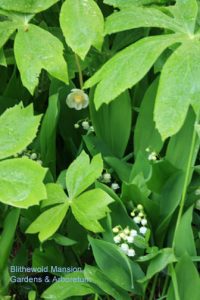Covering ground
 One of the most frequently asked questions lately is “what is that pretty groundcover that’s … everywhere?” Some people seem to ask the question with the “I want that” eye twinkle. (You don’t really want it.) Others appear to cringe as if they’re afraid to know the answer. (Be afraid. Be very afraid.) Goutweed (Aegopodium podagraria) is a scourge and a plague on all our houses – if we have been unlucky enough to inherit it. Bishop’s weed was introduced in this country by early European settlers as an ornamental groundcover and quickly established itself as a weedy invasive capable of out-competing our natives. (It is described only as “weedy” on RI Natural History Survey Invasives List because it hasn’t escaped cultivated areas here. Yet. It is listed as an invasive on Connecticut’s Invasive Plants List.)
One of the most frequently asked questions lately is “what is that pretty groundcover that’s … everywhere?” Some people seem to ask the question with the “I want that” eye twinkle. (You don’t really want it.) Others appear to cringe as if they’re afraid to know the answer. (Be afraid. Be very afraid.) Goutweed (Aegopodium podagraria) is a scourge and a plague on all our houses – if we have been unlucky enough to inherit it. Bishop’s weed was introduced in this country by early European settlers as an ornamental groundcover and quickly established itself as a weedy invasive capable of out-competing our natives. (It is described only as “weedy” on RI Natural History Survey Invasives List because it hasn’t escaped cultivated areas here. Yet. It is listed as an invasive on Connecticut’s Invasive Plants List.)
It is pretty, no doubt about that and some nurseries actually sell an even more attractive variegated variety (Aegopodium podagraria ‘Variegatum’) – which, like many variegateds may be slightly slower to establish but may also at any time revert to plain green and perform a hostile takeover of your garden and the neighboring woods. In the AHS A-Z Encyclopedia the plant size is listed as 12-24″ x indefinite. That kind of says it all.
Goutweed is blanketed throughout Blithewold, particularly in the Bosquet and continually inserts itself in the gardens where we declare War. When the Idea Beds in the Display Garden were first designed (before my time – and before our current redesign of that garden) the beds spent an entire growing season beneath heavy black plastic before anything could be planted. The North Garden was entirely un-planted and replanted (also before my time) to remove the weed from infested perennials and volunteers combed roots out of the beds. And still it emerges where it isn’t welcome. The roots, bright white and as easily recognizable as the equally obnoxious bright orange bittersweet, break with the merest tug and resprout. For that reason it is uncompostable and evicted from the property.
Fred (dir. of hort.) and Dan have been waging their own war with the goutweed. Each summer they weedwhack it all before it can set seed – the flowers are pretty little white lace flower umbels – and wherever they’ve been able to beat back the goutweed, they plant creeping myrtle a.k.a. periwinkle (Vinca minor) and other less aggressive groundcovers, like this patch of native creeping phlox (Phlox stolonifera) and foam flower (Tiarella cordifolia) behind the summerhouse.
 Groundcovers are generally thuggish by nature – we want them to be to a certain extent – and goutweed is certainly not the worst of what can be found infesting the property – we’ve got English ivy and lily-of-the-valley too. And we all have different demons. I could tolerate the spread of creeping phlox for instance, and others I know abhor it as a menace. Do you have goutweed in your garden? Are you plagued by it or something else? How do you manage your overtakers?
Groundcovers are generally thuggish by nature – we want them to be to a certain extent – and goutweed is certainly not the worst of what can be found infesting the property – we’ve got English ivy and lily-of-the-valley too. And we all have different demons. I could tolerate the spread of creeping phlox for instance, and others I know abhor it as a menace. Do you have goutweed in your garden? Are you plagued by it or something else? How do you manage your overtakers?


